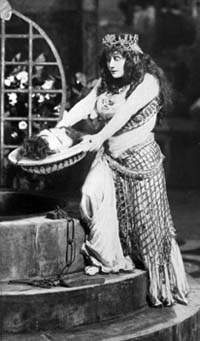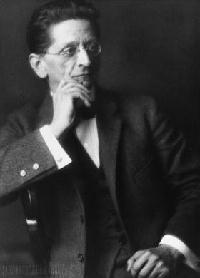Alexander von Zemlinsky, Eine florentinische Tragödie (A Florentine Tragedy), an opera in one act based on the play by Oscar Wilde
Alexander von Zemlinsky, Der Zwerg (The Dwarf), an opera in one act based on Oscar Wilde’s story “The Birthday of the Infanta”
Leon Botstein, conductor, the American Symphony Orchestra, Bard Summerscape 2007, Bard College, Annandale-on-Hudson, New York
The end of the nineteenth century and the first two decades of the twentieth century were a time of almost unparalleled cultural achievement in Vienna. People of the time recognized this. Mark Twain, writing for Harper’s, spent more than a year living in Vienna and chronicling the goings-on; he was fascinated by both the political and cultural aspects of Viennese life of this era. (“Stirring Times in Austria,” Harper’s, Mar. 1898). A great multi-ethnic state had been crafted and aspirations for democracy were running high, but the Danubian monarchy was groaning under attempts to balance these hopes against its own more authoritarian inclinations. The period also pitted the reality of growing (at times almost feverish) nationalism–first among the Italians, then the various Slavic peoples, and then the German and Hungarian “core” populations–against the dream of an empire—Kakanien, as Musil called it. Twain astutely saw a culture in a death-struggle with modernity, and looking back from today, it’s hard to imagine that such a place ever existed. But its cultural legacy is compelling.
This is the unsettled matrix that brought us Freud, and then Schnitzler and Hoffmansthal, Kafka, Werfel, Klimt, Schiele and Kokoshka, the self-satisfied historical eclecticism of the Ringstraße, but also the liberating design of the Secession and Wiener Werkstätte, and finally the music of Strauss and Lehar, but then Mahler, Schoenberg . . . and Zemlinsky. I’ve read and studied this period for some years and came many times upon the name of Alexander von Zemlinsky, but had never—until last night—heard any of his music. He clearly is a figure of the second tier. But his two one-act operas based on works of Oscar Wilde provide evidence of the depth of the intellectual life of the period.
The man we have to thank for that is Leon Botstein, who for many years now has been the great champion of the Viennese musical scene of this period. Hardly a season passes in which he does not dust off and resurrect one forgotten gem or another. His knowledge of the literature is veritably archival, and his sense and taste are unfailing. Leon Botstein is more than an academic and a conductor; he is a sort of bridge to the past who clearly relishes the role.
These two brief operas are minor masterpieces, deeply infused with the thinking and estheticism of turn-of-the-century Vienna. And amazingly, they take as their vehicle two works by Oscar Wilde. The trial that disgraced Wilde and sent him to prison actually produced a surge in Wilde’s popularity on the continent, and especially in the German-speaking world. He was the bad boy who took a stand against English priggishness, against the values of “Manchestertum,” as Thomas Mann called it when he wrote on the fringes of this movement. Wilde’s writings were quickly seen as the peak of the then-emerging esthetic movement.
It’s easy to see that movement as the extreme pendulum swing away from the Neoclassicist ideals of writers like Goethe and Schiller, especially the latter. Schiller had, after all, seen beauty as the embodiment of certain idealized abstractions—particularly of freedom. But the Estheticists found this objectionably priggish. They wanted art for art’s sake. And they saw beauty in any number of dark, inexplicable, and even animal forces. Indeed, you might even say they saw beauty in decay, or even degeneracy (Schönheit aus dem Untergang, in the German formulation). Wilde, and particularly his late, tragic stage, gave life to this thinking in a powerful way.
Zemlinsky’s music and his setting of the Wilde texts bring into focus exactly the aspects of Wilde that so captivated the Viennese. They want to probe the psychological subtexts of his work, and they want to challenge the classical values which formed the accepted starting point for their own literary tradition. The vernacular that supports this exploration was always the Romantic, and Zemlinsky’s music seems a development of that tradition–call it Neoromanticism. Listening to it, I heard, especially in the Florentine Tragedy, much that reminded me of Richard Strauss, especially his use of brass instruments both to punctuate and carry themes, and then, in the far more sentimental and Orientalist The Dwarf, idioms that were closer to Mahler and even Lehar. All of this suggests that Zemlinsky is fully a creature of his time and place, not a revolutionary by any stretch. The compositions are compelling, sometimes melodic and sweet, and sometimes filled with angst. If there was one workhorse of the operatic literature that these two operas seem proximate, then it is the most successful working of Oscar Wilde, namely, Richard Strauss’s Salomé.

Florentine Tragedy
Both works benefit from very thoughtful set and costume designs—the first restrained, and the second exuberant. In Florentine Tragedy, the curtain rises to an inset stage, the interior of an apartment completely in white, with three characters, each clad in a primary color (when they are clad—the opera opens with the return of the Florentine merchant Simone to find his wife Bianca in amorous embrace with Guido Bardi, the son of the duke of Florence). We learn that Bianca has only contempt for her husband, whom she terms a crude merchant, and would love to see him dead so she can pursue her liaison with the ruler’s son.
At length a duel ensues, Guido draws first blood, but then it deteriorates into a brawl, and Simone strangles Guido in his powerful grasp. Simone then turns to Bianca, to kill her for her betrayal. And then a magical transformation occurs. Bianca has become enraptured by the beauty of Simone’s brute strength as he murdered her paramour. She falls back in love with her husband, and suddenly the love is reciprocated. “Why didn’t you tell me you were so beautiful?” Simone sings as the curtain falls. Beauty is thus connected with something perverse—the murder of a youth by a rough, physically unappealing, but still strong elderly man. And beauty is linked immediately to carnal desire. This “Florentine Night” is thus a sort of transfigured night, though the transfiguration is nothing that would provide a moral lesson.
It is curious that virtually every possible erotic combination is tried in the course of the brief hour in which this opera plays. Guido for Bianca; Bianca for Guido; Bianca for Simone; Simone for Bianca. It is “modern” especially in that the female figure appears not simply as the object of erotic desire, but as a person filled with lust for men; and that lust is linked quickly to violence and death. The only missing combination would of course be Simone and Guido, and given Wilde’s habits that very likely ran through the author’s thoughts—and Zemlinsky’s. But in the end neither Wilde nor Zemlinsky are exactly revolutionaries; they push on the boundaries, they shock, but they avoiding crossing the lines that social convention forbids. Still in this piece, they are exploring the psychological underpinnings of this tale—marital infidelity and its causes. They let sexual impulses run wild; social convention is consumed and demolished by them.

The Dwarf
The second work fits the fairy-tale genre, and Zemlinsky’s scoring accentuates the Oriental aspects. A Spanish infanta (daughter of the king) is about to celebrate her eighteenth birthday–her coming of age, in a sense. It is a day of excitement for the birthday girl, and also the only day on which her stern father allows her to play with others of her own age (otherwise, the etiquette of the Spanish court limits her dealings to those of suitable rank). She has received a wonderful pile of presents, and then comes an oddity: the Turkish sultan has sent her a dwarf. He emerges from a burlap bag, deformed. He has reddish bristles, not hair, and is a hunchback, an outcast.
The dwarf is called upon to entertain, and he sings of his love for the infanta, to the shock of the audience. He proves his genius, his artistry, his complex internal personality. This dwarf is an artist. There is no doubt that Wilde, especially in his last years, saw himself in this dwarf—a man who entertains the shallow public, but is held in horror by it because of his deformity (namely, his sexual orientation, which had by then been revealed). And the work’s appeal to Zemlinsky had the same obvious appeal; moreover, Zemlinsky was a notoriously stumpy and ugly figure. Alma Mahler had cuttingly referred to him as “the gnome,” and many of his Viennese contemporaries would have understood the irony in his decision to change the title.
The infanta responds to the dwarf’s expressions of affection with a coy tease. She even says she will reward him by arranging his marriage to one of the ladies at the Spanish court—which produces shouts of horror from the girls assembled around her. The infanta goes off to dance with her friends, and the dwarf looks into a mirror and sees, apparently for the first time, just how hideous he is. The realization is crushing to him, and his suicide follows. The infanta’s reaction: “oh what a shame to have lost such a wonderful toy!” She returns to the dance floor. Physical beauty and moral beauty have thus been perfectly mismatched: the great soul is found in the deformed and twisted body; the beautiful princess is heartless, cold, perverse and self-centered. It is a perfect fairy tale, with good psychological depth. To the infanta belongs Wilde’s famous quip of which Sherry Lee reminds in her program notes: “Only the shallow know themselves.” For those committed to a deeper exploration, the process can only be a process; there is no ultimate ending, save, as in the dwarf’s case, death. As in the prior opera, in The Dwarf, beauty and death appear side-by-side, and inseparable and haunting pairing.
The two works are well-matched on many levels, and Zemlinsky’s music seems a perfect marriage for Wilde’s plot lines. The psychological element is strong, and Zemlinsky affords it the Viennese twist. The symbolist imagery is impressive and memorable. These works may be set in Florence or in the Prado, but their language and thoughts give us Vienna around 1900. (One would have to note that given Zemlinsky’s completion date of 1920, they seem rather late arrivals, however. Time had rather moved on when these works appeared. And that may explain why they seemed a bit outdated when they were finally released by Zemlinsky.)
Thanks should be expressed to Leon Botstein for his very inspired presentation of these two forgotten works. He continues to show us the depth of our cultural heritage, and especially of those decades at the turn of the century in Vienna which in so many ways defined what we see as modern.



